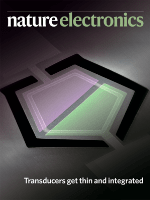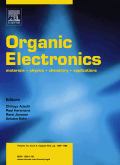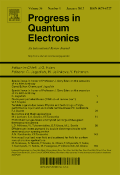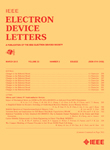
Nature Electronics
Scope & Guideline
Pioneering Innovations in Electronics
Introduction
Aims and Scopes
- Advanced Electronic Materials:
The journal highlights research on novel materials, particularly two-dimensional materials and organic semiconductors, that enhance the performance of electronic devices. - Wearable and Bioelectronics:
A significant focus is placed on the development of wearable electronics that monitor health and environmental conditions, integrating sensors and electronic functionalities into everyday life. - Neuromorphic and AI-Driven Electronics:
Research on neuromorphic computing systems and AI-integrated electronics is emphasized, showcasing innovations that mimic biological processes for enhanced computational efficiency. - Energy-Efficient Devices:
Nature Electronics covers advancements in energy-efficient electronic devices, including low-power circuits and energy harvesting technologies, to address global energy challenges. - Integration of Photonics and Electronics:
The journal explores the integration of photonic components with electronic devices, facilitating advancements in communication technologies and sensor applications. - Flexible and Stretchable Electronics:
There is a strong emphasis on flexible and stretchable electronic devices that can conform to various surfaces and applications, especially in wearable technology. - Quantum and Spintronics:
Research on quantum devices and spintronic technologies is also a core area, with a focus on developing next-generation computing architectures.
Trending and Emerging
- Wearable Health Monitoring Technologies:
There is a surge in research focused on wearable health monitoring technologies, driven by the increasing demand for personal health tracking and remote patient monitoring. - AI and Machine Learning in Electronics:
The integration of AI and machine learning techniques into electronic systems is trending, with research exploring smart algorithms for data processing and device optimization. - Sustainable and Biodegradable Electronics:
Emerging themes include the development of sustainable and biodegradable electronic materials, reflecting a growing awareness of environmental impacts and the need for eco-friendly solutions. - 2D Materials and Heterostructures:
The exploration of two-dimensional materials and their heterostructures is gaining momentum, with researchers investigating their unique properties for diverse electronic applications. - Quantum Computing and Spintronics:
Research in quantum computing and spintronic devices is on the rise, focusing on novel architectures and materials that leverage quantum phenomena for next-generation computing. - Flexible and Stretchable Devices:
The trend towards flexible and stretchable devices is becoming more pronounced, driven by advances in materials science that enable new applications in wearable technologies and soft robotics.
Declining or Waning
- Traditional Semiconductor Scaling:
The focus on traditional semiconductor scaling is declining, as researchers increasingly shift towards novel materials and architectures that offer better performance without solely relying on Moore's Law. - Conventional Photovoltaic Technologies:
Research on conventional photovoltaic technologies is becoming less prominent, with a noticeable trend towards exploring new materials and hybrid systems that enhance energy conversion efficiencies. - Basic Circuit Design:
The emphasis on fundamental circuit design principles is waning, as the field moves towards more complex integrated systems that leverage advanced materials and AI-driven functionalities. - Analog Electronics:
There has been a noticeable decrease in publications focused on traditional analog electronics, as the field increasingly gravitates towards digital and mixed-signal solutions. - Single-Function Devices:
Research on single-function devices is diminishing, with a growing preference for multifunctional systems that integrate various capabilities into a single platform.
Similar Journals

Electronic Materials Letters
Pioneering Research for Tomorrow's TechnologiesElectronic Materials Letters is a distinguished journal dedicated to the dissemination of research in the field of electronic, optical, and magnetic materials. Published by the Korean Institute of Metals and Materials, this journal has established itself as a critical platform for scholars and practitioners since its inception in 2008, with coverage extending through 2024. With an ISSN of 1738-8090 and an E-ISSN of 2093-6788, it has achieved a commendable Q3 categorization for 2023, ranking 107 out of 284 in the Scopus database's specialized field, reflecting its relevance with a 62nd percentile position among its peers. Although this journal operates under a traditional access model, its rigorous peer-review process ensures that only the most impactful research reaches its audience, thereby maintaining high scholarly standards. Positioned in South Korea at the heart of technological innovation, Electronic Materials Letters plays a vital role in bridging the gap between theoretical investigations and practical applications, making it an essential resource for researchers, industry professionals, and students aiming to thrive in the rapidly evolving materials science landscape.

OPTICAL AND QUANTUM ELECTRONICS
Connecting Theory and Application in Quantum ElectronicsOPTICAL AND QUANTUM ELECTRONICS, published by SPRINGER, is a premier journal dedicated to advancing the fields of atomic and molecular physics, optics, and electronic engineering. With an ISSN of 0306-8919 and an E-ISSN of 1572-817X, this journal has established itself as a vital resource for researchers, professionals, and students alike, contributing to the discourse from its inception in 1969 to its continued publications through 2024. It holds impressive rankings in Scopus, placing within the top percentiles for its categories, specifically in the 64th for Electrical and Electronic Engineering and 63rd for Atomic and Molecular Physics. Though it does not currently offer open access options, the journal's robust impact factor reflects its importance within its field, making it an essential reference point for cutting-edge research and developments in materials science and optics. Through its rigorous peer-review process, OPTICAL AND QUANTUM ELECTRONICS remains committed to publishing high-quality, influential studies that push the boundaries of innovation and understanding in these dynamic areas of science.

ORGANIC ELECTRONICS
Pioneering the Future of Organic MaterialsORGANIC ELECTRONICS, published by Elsevier, is a premier journal dedicated to the rapidly evolving field of organic electronics, encompassing a spectrum of interdisciplinary research from materials chemistry to electrical engineering. As a crucial resource for researchers, professionals, and students, the journal boasts significant impact, currently ranked in the Q2 category across multiple fields, including Condensed Matter Physics, Materials Chemistry, and Electrical and Electronic Engineering. With a commitment to advancing knowledge and innovation from its base in the Netherlands since its inception in 2000, ORGANIC ELECTRONICS not only provides critical insights into organic materials and their applications but also fosters collaboration among scientists through its comprehensive findings and high-quality articles. The journal does not currently offer open access but provides various access options for subscribers. With its HIndex signaling substantial academic output and engagement, ORGANIC ELECTRONICS remains an essential platform for groundbreaking research that is shaping the future of technology.

PROGRESS IN QUANTUM ELECTRONICS
Connecting Ideas in Quantum and Materials SciencePROGRESS IN QUANTUM ELECTRONICS, published by PERGAMON-ELSEVIER SCIENCE LTD, is a premier international journal that serves as a critical forum for the dissemination of high-quality research in the fields of atomic and molecular physics, electrical engineering, and materials science. With its esteemed Q1 category ranking in several disciplines, including Atomic and Molecular Physics, Electrical and Electronic Engineering, and Electronic, Optical and Magnetic Materials, this journal commands a high impact factor and is recognized for its rigorous peer-review process. Established in 1969 and evolving through various phases, the journal currently compiles cutting-edge research that drives advancements in quantum technologies. Researchers, professionals, and students alike are invited to explore a wealth of knowledge and stay updated on pioneering developments in quantum electronics, enhancing their understanding and contributing to the progression of this dynamic field.

INFORMACIJE MIDEM-JOURNAL OF MICROELECTRONICS ELECTRONIC COMPONENTS AND MATERIALS
Transforming Ideas into Groundbreaking Microelectronics ResearchINFORMACIJE MIDEM - JOURNAL OF MICROELECTRONICS ELECTRONIC COMPONENTS AND MATERIALS is a prominent open-access journal published by SOC MICROELECTRONICS, ELECTRON COMPONENTS MATERIALS-MIDEM in Slovenia, dedicated to advancing knowledge in the fields of microelectronics, electronic components, and materials. Since its inception in 1988, the journal has provided a platform for groundbreaking research and innovations, ensuring that all published work is freely accessible to a global audience. With an impressive history of publication from 1996 to 2024, INFORMACIJE MIDEM is indexed in Scopus, holding respectable ranks in categories such as Electrical and Electronic Engineering (Rank #525/797, Percentile 34th) and Electronic, Optical, and Magnetic Materials (Rank #204/284, Percentile 28th). While currently classified in the Q4 quartile for the year 2023, the journal serves as an essential resource for researchers, professionals, and students seeking the latest developments in microelectronics and related fields, fostering a collaborative academic environment and contributing to the advancement of technology and materials science.

Journal of Electrical Engineering & Technology
Driving Innovation through Rigorous Research and ReviewJournal of Electrical Engineering & Technology is a prominent academic journal published by SPRINGER SINGAPORE PTE LTD, dedicated to advancing the field of Electrical and Electronic Engineering. With an established history since 2008, the journal has become a vital resource for professionals, researchers, and students seeking to explore innovative research and technological developments within the discipline. The journal boasts a commendable 2023 Scopus Rank of #334 out of 797 in its category, reflecting its quality and the impact of published works. As a Q2 category journal, it upholds rigorous peer-review standards, making it a credible platform for disseminating groundbreaking findings. While currently not an open-access publication, the journal ensures that its content is accessible to a global audience committed to knowledge enhancement and technological progress. Subscribe or access issues through institutional affiliations to stay at the forefront of advancements in electrical engineering.

Frontiers of Optoelectronics
Pioneering Research in Electrical and Optical EngineeringFrontiers of Optoelectronics is a prestigious peer-reviewed journal published by HIGHER EDUCATION PRESS, focusing on the rapidly evolving fields of electrical engineering, optical science, and material science. With its inception in 2012 and an impressive impact factor achieved by being ranked Q1 in both Electrical and Electronic Engineering and Electronic, Optical and Magnetic Materials as of 2023, this journal exemplifies excellence in research dissemination. Operating under an Open Access model since 2022, it ensures timely and widespread accessibility to cutting-edge advancements and innovative applications in optoelectronics, making it an essential resource for researchers, professionals, and students alike. The journal is indexed in Scopus, with notable ranking positions—Rank #143/797 in Electrical and Electronic Engineering and Rank #55/284 in Electronic, Optical and Magnetic Materials—highlighting its significant contribution to the academic community. Based in Beijing, China, the journal fosters a global dialogue around key technological trends, ultimately driving further development in the field.

npj Flexible Electronics
Shaping the Landscape of Electronic Materialsnpj Flexible Electronics, published by NATURE PORTFOLIO, is a premier open-access journal dedicated to the rapidly advancing field of flexible electronics. Since its inception in 2017, the journal has gained significant recognition, boasting impressive rankings as a Q1 journal in both Electrical and Electronic Engineering and Materials Science based on the 2023 metrics. With its E-ISSN 2397-4621, the journal serves as an essential platform for researchers, professionals, and students alike, facilitating the dissemination of high-quality research articles, reviews, and insights that drive innovation across multidisciplinary applications. Operating from its base in Berlin, Germany, and characterized by a robust impact within the academic community, npj Flexible Electronics plays a critical role in shaping the future of electronic materials and devices. The journal offers comprehensive open access options, ensuring that cutting-edge research is readily available and widely disseminated, fostering collaboration and engagement within the global research community.

IEEE ELECTRON DEVICE LETTERS
Elevating Knowledge in Electronic MaterialsIEEE Electronics Device Letters, published by the esteemed IEEE-Institute of Electrical and Electronics Engineers Inc, stands at the forefront of innovation in the field of electrical and electronic engineering. With a rich history spanning from 1980 to 2024, this journal showcases groundbreaking research and letters that significantly contribute to the advancement of electronic, optical, and magnetic materials. Its impressive Q1 rankings in both Electrical and Electronic Engineering and Electronic, Optical, and Magnetic Materials underscore its pivotal role in shaping contemporary academic discourse. The journal maintains a strong position in Scopus rankings, positioned within the top 16% for Electrical and Electronic Engineering and the top 18% for Materials Science, making it a vital resource for researchers, professionals, and students alike. With the absence of open access, it maintains an exclusive repository of high-impact research that experts in the field turn to for the latest insights and developments. IEEE Electronics Device Letters is committed to providing a platform for the dissemination of transformative knowledge that fuels innovation and progress in the ever-evolving landscape of electronics.

Nano Materials Science
Connecting Researchers with Cutting-edge Discoveries.Nano Materials Science is a premier open-access journal dedicated to the dissemination of groundbreaking research in the fields of nanotechnology, materials science, and chemical engineering. Published by KEAI PUBLISHING LTD, this journal has quickly established itself as a leading platform in its area since its inception in 2019, with impressive rankings in the Scopus database, holding a Q1 position across multiple categories, including Chemical Engineering and Materials Science. Based in Beijing, China, Nano Materials Science provides researchers and practitioners access to a wealth of high-quality peer-reviewed articles, fostering innovation and collaboration within the scientific community. With its impact factor steadily rising and a commitment to open access, the journal aims to bridge the gap between theoretical research and practical applications, making it an essential resource for professionals and students eager to stay at the forefront of materials research and nanotechnology advancements.